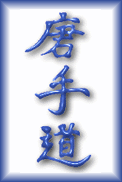Tangsoodo or Tang Soo Do is a traditional Korean martial art. Translating the word “Tang Soo Do” is hard: The word “Soo” means “hand”, however the word “Tang” has many meanings such as “Worthiness”, “Skillful”, and “Strong”. Since the name does not translate well today, many people are content with the definition “Way of the empty hand”.
Tang Soo Do (Hangul: 당수도) is the Korean pronunciation of the Hanja characters 唐手道. In Japanese these characters mean ‘Karate-do’ but in contemporary Japanese Karate-do is written as 空手道. The Japanese pronunciation of both sets of characters is the same, but the newer version means “Way of the Empty Hand” rather than “Way of the T’ang Hand”, although it could also be interpreted as “Way of the China Hand” or “Way of the Knife Hand”.
The first recorded use of the term “Tang Soo Do” in contemporary history was by Chung Do Kwan founder, Won Kuk Lee . Prior to the unification of the Kwans under the Korea Taekwondo Association, most of the major Kwans called their style Tang Soo Do, or Kong Soo Do. The Chung Do Kwan, along with the rest of the Kwans, stopped using the name ‘Tang Soo Do’ and ‘Kong Soo Do’ when they unified under the name Taekwondo (and temporarily Tae Soo Do). The Moo Duk Kwan, being loyal to Hwang Kee, pulled out of the Kwan unification and remained independent of this unification movement, continuing to use the name ‘Tang Soo Do’. The majority of Moo Duk Kwan members followed Hwang’s senior student, Chong Soo Hong, to become members of a unified Taekwondo. Their group still exists today and is known as Taekwondo Moo Duk Kwan (Moo Duk Hae) with an office in Seoul, Korea.
In 1995 the late Hwang Kee officially changed the name of the Moo Duk Kwan style to Soo Bahk Do.
Most schools of Tang Soo Do use the transcription “Tang Soo Do”. However, scientific texts apply the official transcription ‘tangsudo’, written as one word. Some authors write “Tang Soo Do” and give “tangsudo” or “dangsudo” in the parenthesis.
Unlike most contemporary martial arts, it is not possible to pinpoint any one person as being the “founder” of Tang Soo Do. One could argue that Won Kuk Lee founded the style, being the first known person to use the name; that argument would be dubious, at best. However, the Moo Duk Kwan style of Tang Soo Do (from which nearly all modern Tang Soo Do stylists trace their lineage) can be traced to a single founder: Grandmaster Hwang Kee. Hwang Kee claimed to have had learned Chinese martial arts while in Manchuria. However, all other Kwan seniors say there is no proof for this claim. He also claimed influence by Japanese Karate, and the indigenous Korean arts of Taekkyon (택견) and Subak. However, Korea Taekkyon Association Grandmaster Yong Bok Lee states these claims are not true. Hwang Kee also claimed to have been highly influenced by an old book about martial arts called the Muye Dobo Tongji (1790).
Won Kuk Lee, the founder of Chung Do Kwan, has Hwang Kee listed in his records as a 5th Geup (about green belt level). He states that Hwang came to him to learn the correct movements of Karate, as Hwang found a Karate book by Gichin Funakoshi, who was Lee’s teacher. In 1945 Hwang Kee organized the Korean Soo Bahk Do Association. In 1968, Master Jae C. Shin, who studied directly under Grandmaster Hwang Kee, founded the United States Tang Soo Do Federation, though he later left this organization in order to start his own, The World Tang Soo Do Association in 1982. (武藝圖譜通志 / 무예도보통지).
Discuss Tang Soo Do
Tang Soo Do Websites


Leave a reply to Tang Soo Do